- EU-UK said to be putting finishing touches on Brexit deal outline
- US stimulus remains undecided
- Equities move higher
Key Events
US contracts for the S&P 500, Dow Jones, NASDAQ and Russell 2000 all rose on Thursday and European stocks jumped as the UK and European Union neared a Brexit deal}}. The news has put investors in a festive mood ahead of the Christmas holiday.
Renewed risk-on appetite pushed the dollar and Treasury yields higher.
Global Financial Affairs
US futures this morning built on yesterday's advance, the first in four days, notwithstanding that investors await developments in the latest 'plot twist' to the still-ongoing saga surrounding a second round of US Congressional stimulus. The latest surprise development occurred on Tuesday night when President Donald Trump announced he would be vetoing the $900 billion coronavirus relief package, demanding that individual payments be raised from $600 to $2000.
The President's ultimatum could delay making the bill fully official and postpone the much-needed funding, bad news for markets and many unemployed American citizens ahead of the year-end holidays.
Still, with the EU and UK on the cusp of a Brexit deal, the STOXX Europe 600 Index gapped up 0.2% at the open and extended the advance to 1.1% as of the time of writing. Negotiators worked through the night and have arrived at an outline for the 'divorce' agreement and are now said to be working on the finishing touches. The pan-European benchmark is now hovering within 0.5% of its highest levels since February.
In the UK though, a 0.3% higher open fizzled, leaving the FTSE 100 little changed on Thursday. Perhaps, a strengthening pound—which would make UK exports less competitive—weighed on stocks.
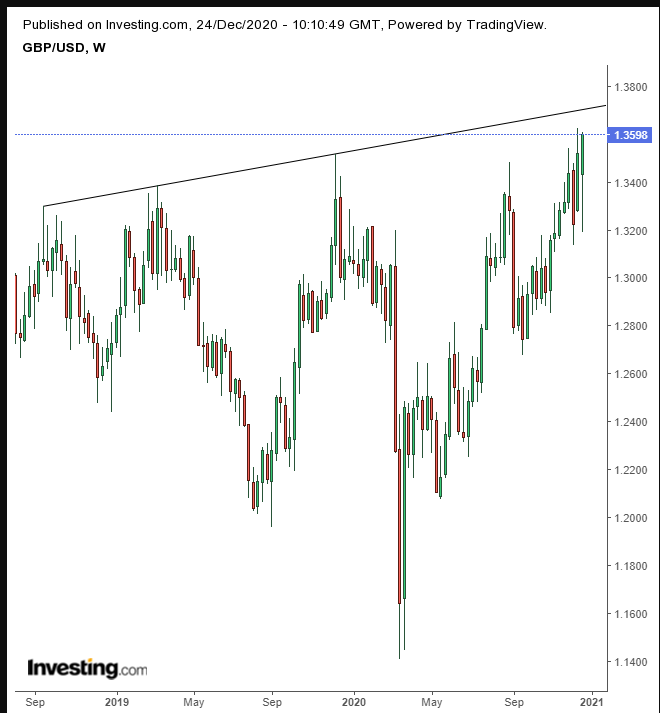
Cable gapped up 0.2%, something rarely seen in FOREX, extending its advance to 0.8%, bringing sterling to its highest level since May 1, 2018. We've been super bullish on the pound and expect it to go much, much higher. In fact, we anticipate it could regain some of its former glory which would bring it back to the highs before the 2016 Brexit vote.
It’s one thing to be strong against the weakening dollar, but the pound is also on track for an upward reversal against the euro, as well.
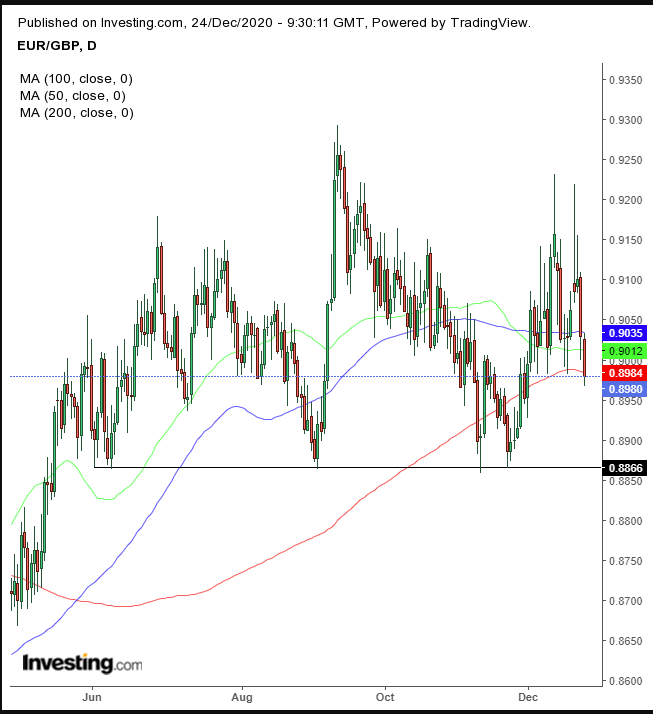
The EUR/GBP pair is completing a small H&S top, whose neckline is organically drawn by the 200 DMA, whose implied target will take on the neckline of a much larger H&S top, of which it makes up the right shoulder.
Earlier Thursday, Asian benchmarks pushed higher, except for China’s Shanghai Composite, (-0.6%), which has been slumping since China's regulators targeted Jack Ma’s business empire for anti-competitive practices in recent months. Alibaba Group Holding (HK:9988) plunged 8% in Hong Kong, weighing on the Hang Seng, (+0.1%).
South Korea's KOSPI jumped, (+1.7%), to a new record as the country secured more COVID vaccines.
On Wall Street, American stocks found their footing Wednesday, after a three-day selloff, even as the market awaits the result of Trump’s demands to increase and alter the virus relief bill.
Bulls proved their resilience once again as they prodded the S&P 500 to a higher close. Why would stocks go up, if reports are saying Trump’s last-minute interference could put the kibosh on the stimulus plan?
Given that the deal was supported overwhelmingly by Congress—with a 92-6 vote for it in the Senate and 359-53 in the House—lawmakers would have enough muscle to override a veto, which requires only two thirds of the legislative members to vote in favor of an override. As well, Trump's demand calls for more aid, not less. So if parsimonious Republicans cave to the President's demands, it would just mean more cash flowing into the market.
The NASDAQ Composite touched an all-time high, while the Russell 2000 notched a record close, in addition to a fresh all-time high. We've previously noted that the cyclical rotation may have reached a peak—three times last week tech shares led the rallies. Now, we’re seeing small cap technology stocks leading. Up until now, they've possessed an inverse relationship with the value-driven advance.
Yields, including for the 10-year benchmark note, opened higher as Treasuries were sold off.
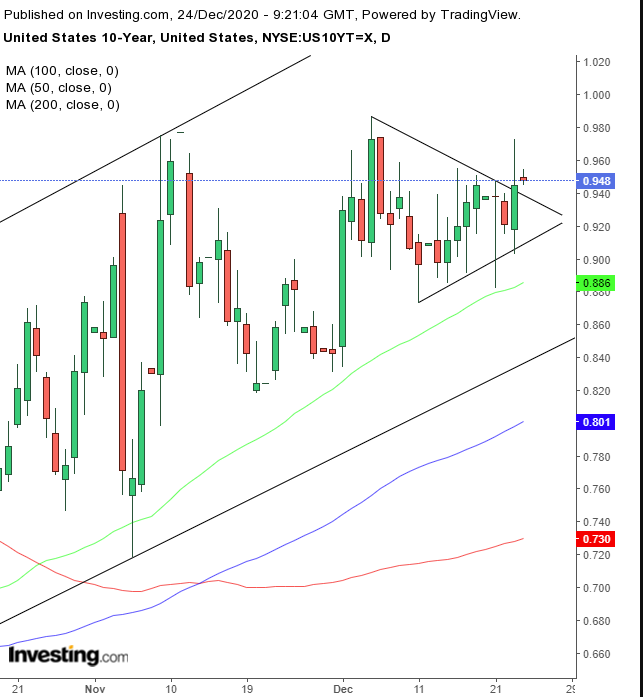
Rates completed a bullish pennant within a rising channel, as investors went in search of risk.
The dollar fell for a second day, despite new stimulus worries.
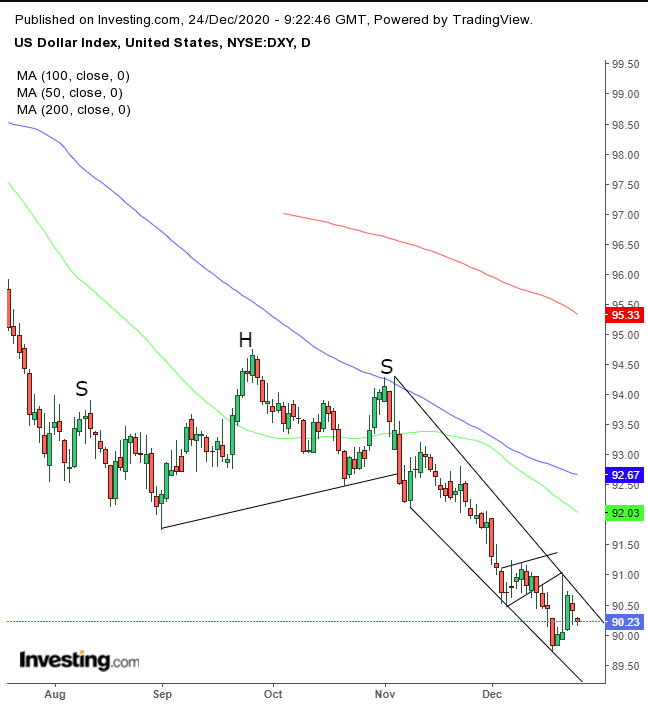
The greenback dropped along a narrow falling channel, after retesting a bearish flag and finding resistance.
Dollar weakness boosted gold, which rose for a second day.
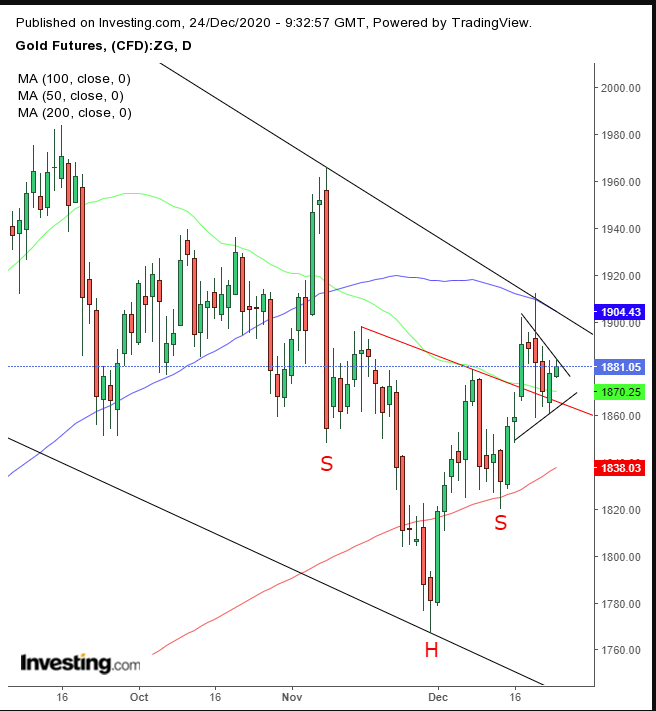
The precious metal confirmed the neckline of a H&S bottom, as it develops a bullish pennant, a sign that bulls are regrouping to break free of a falling channel that has dragged them down since gold's August record.
Bitcoin rebounded into a slight advance.
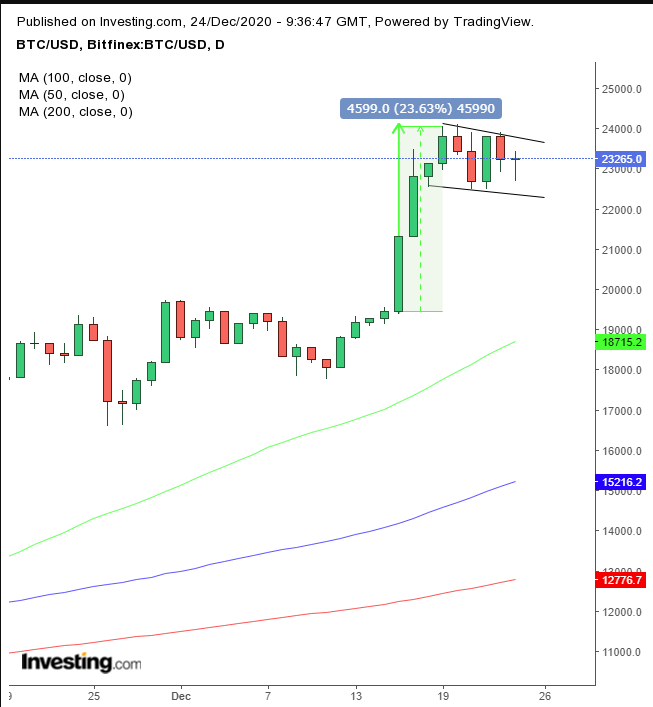
The cryptocurrency is treading water for the seventh session, moving within a falling flag, bullish after the preceding surge. An upside breakout would imply a $28,400 target.
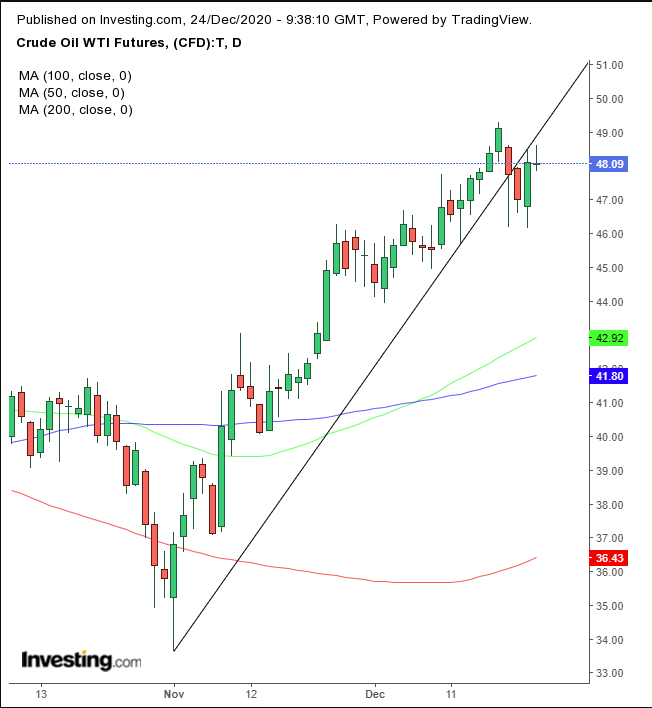
Oil was little changed, even after attempting to climb back above its broken uptrend line since the Nov. 2 low.
Up Ahead
- {{ecl-59||Core Durable Goods Orders for November will be reported on Thursday in the US.
- Canada releases November Building Permits figures on Thursday as well.
- US bond markets and stock markets in other parts of the world close early for Christmas Eve. Most global markets are shut Friday for the holiday.
Up Ahead
Stocks
- Futures on the S&P 500 Index rose 0.2%.
- The Stoxx Europe 600 Index climbed 0.2%.
- The MSCI Asia Pacific Index rose 0.5%.
- The MSCI Emerging Markets Index gained 0.4%.
Currencies
- The Dollar Index dipped 0.2% to 90.22.
- The euro rose 0.1% to $1.2205.
- The British pound jumped 0.6% to $1.3577.
- The onshore yuan strengthened 0.1% to 6.531 per dollar.
- The Japanese was little changed at 103.60 per dollar.
Bonds
- The yield on 10-year Treasuries gained less than one basis point to 0.95%.
- The yield on two-year Treasuries climbed less than one basis point to 0.12%.
- Japan’s 10-year yield gained one basis point to 0.017%.
Commodities
- West Texas Intermediate crude increased 0.4% to $48.29 a barrel.
- Brent crude gained 0.4% to $51.40 a barrel.
- Gold strengthened 0.3% to $1,878.05 an ounce.
